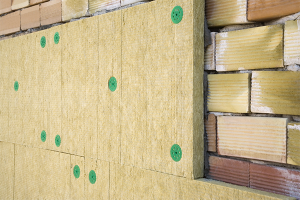معنی فاکتور K، R و C چیست؟
Thermal conductivity (often denoted k) is the property of a material to conduct heat. It is evaluated primarily in terms of Fourier’s Law for heat conduction. Heat transfer occurs at a higher rate across materials of high thermal conductivity than across materials of low thermal conductivity. Correspondingly, materials of low thermal conductivity are widely used as thermal insulation. Thermal Conductivity of materials is temperature dependent. Then, the lower value of K an insulation has, the more it values. Insulations’ K are normally lower than 1. In order to specify the average heat measure both surfaces’ heat and add them together and then divide it by two. The value of factor K and the average heat are both essential in the time of insulation’s value comparison because if the average heat rise, in no time, factor k rises as well. Factor C is actually the same as Factor K with the difference that it is the Factor K divided by the thickness of insulation. Consequently, the less value of C an insulation has, the better insulation it is. Last but not least, factor R is the thermal resistance. Thermal resistance is the ability of a material to resist the flow of heat.Thermal resistance is the reciprocal of thermal conductance, i.e., lowering its value will raise the heat conduction and vice versa. A high quality insulation’s R has higher value.
Thermal bridge
 A thermal bridge occurs when there is a gap between materials and structural surfaces. The main thermal bridges in a building are found at the junctions of facings and floors, facings and cross walls; facings and roofs, facings and low floors. They also occur each time there is a hole (doors, windows, loggias…). These are structural thermal bridges. These thermal bridges vary in importance according to the type of wall or roof (insulated or not).In a building that is not properly insulated, thermalbridges represent low comparative losses (usually below 20%) as total losses via the walls and roof are very high (about >1W/m2K). However, when the walls and roof are very well insulated, the percentage of loss due to thermal bridges becomes high (more than 30%) but general losses are very low (less than 0.3 W/m2K). That is why in low energy consuming buildings, it is important to have very high thermal resistances for walls and roofs to have low heat losses via the junctions. At the design level, it is imperative to choose construction processes and components that reduce surface losses as much as possible and integrate the smallest possible losses in the junctions of these surfaces. Whatever insulation systems are used, there are relevant thermal, acoustic and/or fire safety solutions. Generally, in the case of individual homes, very good floor insulation is needed and, depending on the wall insulation, the floor should be covered with a floating floor or a bricked system with built-in insulation.
A thermal bridge occurs when there is a gap between materials and structural surfaces. The main thermal bridges in a building are found at the junctions of facings and floors, facings and cross walls; facings and roofs, facings and low floors. They also occur each time there is a hole (doors, windows, loggias…). These are structural thermal bridges. These thermal bridges vary in importance according to the type of wall or roof (insulated or not).In a building that is not properly insulated, thermalbridges represent low comparative losses (usually below 20%) as total losses via the walls and roof are very high (about >1W/m2K). However, when the walls and roof are very well insulated, the percentage of loss due to thermal bridges becomes high (more than 30%) but general losses are very low (less than 0.3 W/m2K). That is why in low energy consuming buildings, it is important to have very high thermal resistances for walls and roofs to have low heat losses via the junctions. At the design level, it is imperative to choose construction processes and components that reduce surface losses as much as possible and integrate the smallest possible losses in the junctions of these surfaces. Whatever insulation systems are used, there are relevant thermal, acoustic and/or fire safety solutions. Generally, in the case of individual homes, very good floor insulation is needed and, depending on the wall insulation, the floor should be covered with a floating floor or a bricked system with built-in insulation.
What Is the different between average temperature and ambient temperature?
Temperature is an independent feature and is not a means to measure heat. For instance, the temperature of two cups of coffee one full and the other half-full are the same, whereas the half-full cup only has the half the heat (Btu) the full cup has. The average
temperature is the average for the summation of a cold and a hot surface. All of the above factors, K, C, and R, must be considered in the average temperature.


